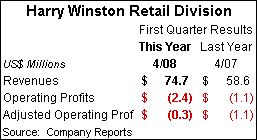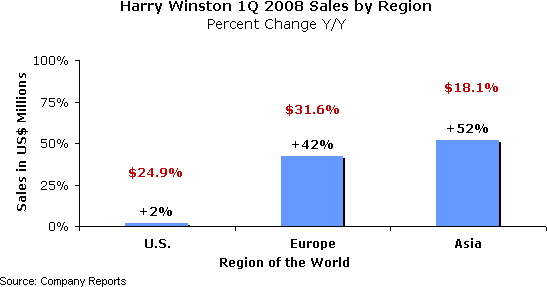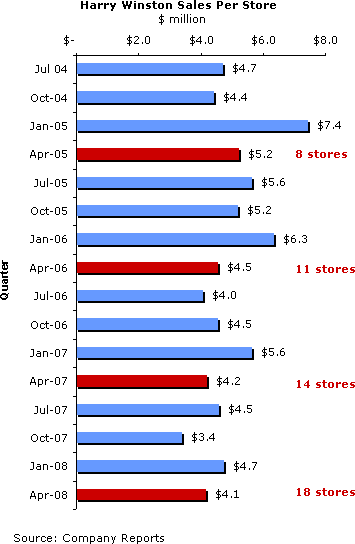IDEX Online Research: Harry Winston Retail Results Rebounds Strongly in Q1
June 23, 08
At first glance, it appears that sales in the retail division of Harry Winston were up, but losses widened in the first fiscal quarter of 2008. After all, this would be a continuation of trends established last year.
But upon reading the fine print and adjusting for one-time non-recurring costs, it appears that this uber-luxury retailer posted both improved sales and a dramatically smaller seasonal loss in the period ended April 2008. This is particularly impressive since seven of its eighteen stores are located in the U.S. where economic conditions are very soft and overall jewelry demand is weak.
Here’s what happened in the Harry Winston retail division in the quarter ended April: the retail segment posted a 27 percent increase in sales to nearly $75 million. Profits, however, were negatively affected by a $2 million non-recurrent cost related to restructuring and improvements at the Geneva watch factory.
This resulted in a reported loss from operations of almost $2.4 million. If this unusual charge – necessary to support on-going operations, but none-the-less unusual, especially since there was not a similar charge last year – is excluded, the retail division would have posted an operating loss of only $0.3 million versus last year’s loss of $1.1 million.
The table below summarizes both reported and adjusted earnings for the first fiscal quarter ended April 2008 for the Harry Winston retail division.

Because Harry Winston’s corporate parent does not provide much information about the financials of the retail division, we are left on our own to analyze results and draw our own conclusions. We use analytical techniques that should yield reasonable conclusions, but we note that some have not been independently verified by the company.
Here are some highlights from the first quarter:
- Management commented that diamond prices in the first quarter continued to rise for larger, better-quality diamonds, while the price of lower-quality diamonds remained unchanged in response to softening U.S. demand. IDEX Online research confirms this trend (most U.S. customers seem to be satisfied with lower quality diamonds while customers in other markets are more discerning). Harry Winston noted that demand in Asian markets remained robust in all price ranges.
- Despite a troubled economy in the U.S., Harry Winston’s global retail sales were very strong – up 27 percent – due to exceptional demand in global markets beyond the U.S. Transactions to Asian, Russian, and Middle Eastern customers more than offset the weakness in the U.S.
The following graph summarizes sales by regional of the world for the retail division. In the U.S., Harry Winston has seven stores; sales were up by 2 percent, as the graph illustrates, to $24.9 million. In Europe, the company’s three stores posted a dramatic gain of 42 percent (sales were $31.6 million); while sales in its eight stores in Asia rose by an even more dramatic 52 percent to $18.1 million.

- While management was not specific about which products drove sales, it mentioned that luxury watch sales were particularly strong, and that it posted an exceptional number of high-value transactions.
- Sales per store were nearly flat with last year – The company does not report same-store sales results for its retail division. However, based on the opening of four new units over the past twelve months, we can assume that those immature stores under-performed more mature stores. Thus, we believe same-store sales for the Harry Winston retail division rose, perhaps by a modest single digit number.
The graph below summarizes sales per store for Harry Winston’s retail division for the past four years.

- As the red bars (first fiscal quarters) show, Harry Winston’s sales per store have been slipping for the past four years. However, this is largely due to new, immature stores which were opened in the period. The total number of stores in operation at the end of the first quarter of each year is shown in red to the right of each red bar.
The company’s U.S. stores are in New York, Beverly Hills, Bal Harbour, Honolulu, Las Vegas, Dallas and Chicago. In Japan, it operates five units: Ginza, Roppongi Hills, Osaka, Omotesando and Nagoya. It also operates three stores in Asia outside of Japan: Beijing, Taipei and Hong Kong. Finally, it operates three stores in Europe: Paris, London and Geneva.
- Gross margin – 45.1 percent vs 47.8 percent – Harry Winston’s first quarter gross margins were negatively affected by three factors: 1) a greater number of high-value transactions which carry an inherently lower margin; 2) higher costs of precious metals and gemstones; and, 3) larger research and development costs related to its growing watch business. If the negative impact of the sale of pre-acquisition inventory is removed from the gross margin calculation, this year’s gross margin would have been 47.3 percent versus 51.6 percent last year. It appears that this pre-acquisition inventory is finally having a waning impact on overall retail gross margins. We continue to wonder why the company doesn’t just write it off – after all, the inventory is more than four years old.
- Operating cost ratio – 48.3 percent vs 49.7 percent – Expense control and sales leverage helped bring down the company’s operating cost ratio in the quarter. Excluding the unusual charges related to renovations, improvements, and restructuring at its Geneva watch facility, the company’s operating cost ratio would have been an estimated 45.5 percent of sales, dramatically below last year’s levels of 49.7 percent.
Disproportionally higher costs were recorded in salaries, benefits and depreciation/amortization. A decline of $1.1 million in advertising and selling expenses partially offset these higher costs.
- A new store is slated to open in the current quarter in Costa Mesa, California. This is the only new store planned for 2008.
- Harry Winston introduced new watches at the Basel show, and orders were significantly higher than last year, a reflection of the continued strength of the watch business.
- Management’s outlook calls for sales in the retail division to grow by 15 percent this year. While the U.S. remains weak, demand is being driven by consumer spending in Asia, Russia and the Middle East.